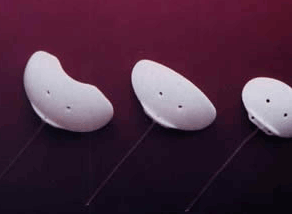Glaucoma Drainage Implants

In some patients, particularly those with certain types of glaucoma, the standard trabeculectomy is known to be less successful in reducing intraocular pressure. A surgical alternative in these individuals utilizes a glaucoma implant or glaucoma drainage device.
These implants come in different shapes and sizes (Figure 1). With each of them, a plastic tube is inserted into the front of the eye behind, but not touching, the cornea. The tube is like an artificial drain, and fluid passes through it to the outer layers of the eye. It should be noted that the glaucoma implant is not used to improve vision, but to lower intraocular pressure. In this respect, it is completely different from the type of implant which is used during cataract surgery.

Glaucoma implants come in many shapes and sizes. A clear thin tube is placed into the front part of the eye and is connected to a reservoir (white) outside the eye.
Glaucoma implants are not new. In fact, the idea of controlling intraocular pressure with an external tube has been tested for almost 100 years. Some of the materials that have been tried include horsehair, silk, and tubes of gold.
The long-term success in the early days was poor and the complication rate was quite high. However, with improved surgical techniques and the use of plastics, glaucoma implants are now acceptable and promising therapy.
The patients most likely to benefit from this procedure are those in whom a more standard glaucoma operation, such as trabeculectomy, is not expected to be successful. In general, these are patients who have previously undergone eye surgery more than once.
Occasionally, a glaucoma implant will be recommended as an initial surgical procedure. In these patients, the implant is necessary because there is expected to be extensive scarring in the outer layers of the eye. Compared to the channel made with trabeculectomy, the tube of the glaucoma implant is less likely to become blocked by this scar tissue.
Glaucoma implant surgery is usually performed with local anesthesia. There is little discomfort following surgery except for a minor irritation. Most patients do not require overnight hospitalization. After the operation, however, some eye drops may be prescribed to ensure healing without infection.

The clear tube is seen through the cornea. The reservoir cannot be seen because it is covered by the eyelid and outer portions of the eye.
Immediately after the surgery, intraocular pressure may not be lower. Depending on how the surgery is performed, glaucoma medications may be continued during this period.
Glaucoma implants are usually placed in the area underneath the upper eyelid (Figure 2). Unless the lid is pulled back, neither you nor your family will notice it. With the upper lid retracted, a white patch may be noted. This is a patch that covers the tube and prevents irritation.
Since glaucoma implants are used in patients with more complicated problems, the success rate is slightly lower than a standard trabeculectomy. However, in many patients, these implants may be the best remaining available option.
Remember that the goal of glaucoma implant surgery is to lower intraocular pressure and preserve vision. It will not restore vision that already has been lost.

